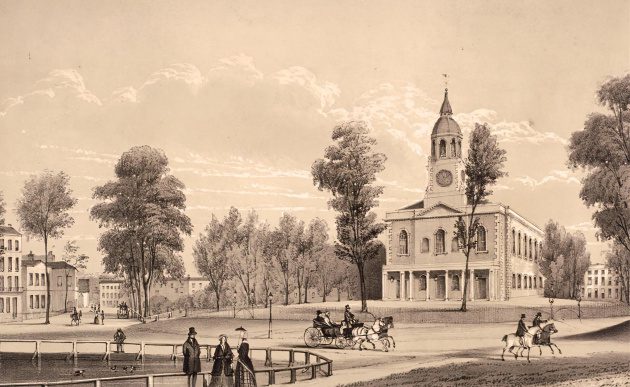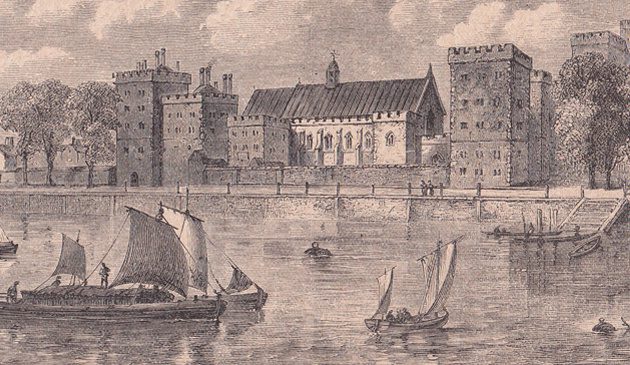All Hallows by-the-Tower church

The old church of St. Hallows-by-the-Tower as it was in the past, prior its devastation during the Second World War. The 17th century tower survived and a steeple was added to it during the early 1950s.
The Great Fire of London began a short distance away. Samuel Pepys then lived close by and often mentioned All Hallows in his diaries. On 5th September 1666 he wrote:
About two in the morning my wife calls me up and tells me of new cryes of fire, it being come to Barkeing Church, which is at the bottom of our lane. I up and finding it so, resolved presently to take her away, and did, and took my gold, which was about 2350/ (£2,350).
The fire came down Tower Street, destroying the vicarage and scorching the clock and porch, but stopped short of the church itself. William Penn, founder of Pennsylvania, was baptised in All Hallows in October 1644. His father, Admiral Sir William Penn, who had been responsible for the capture of Jamaica from the Spanish, watched the Great Fire from the church tower, together with Pepys. The Admiralty building was close by and Penn snr. had surrounding buildings blown up to create a fire break. Pepys recorded in his diary:
I up the top of Barkeing steeple, and there saw the saddest sight of desolation I ever saw. Everywhere great fires, the fire being spread as far as I could see it.
Judge George Jeffeys, the infamous ‘Hanging Judge’, married his first wife at All Hallows in 1667. John Quincy Adams, the sixth President of the United States and son of John Adams, the second President, was married to Louisa Johnson of London at All Hallows in July 1797. She is the only First Lady to be born outside of the United States.
Between 1680 and 1686 the vicar of All Hallows was Dr. George Hickes. From 1681 he was also chaplain to the king. At the Glorious Revolution he refused to take the Oath of Allegiance to King William and Queen Mary for which he was deprived of his living. He went into hiding in London before departing for France to meet the deposed King James on a mission to arrange the consecration of new bishops. Hickes was a highly learned man and an expert in Anglo-Saxon languages.
The Reverend ‘Tubby’ Clayton founded the Toc H charity as a rest and religious house for soldiers of all ranks at Ypres in Belgium in 1915 during the First World War. Following the war Toc H continued as a charity in London with various branches as far as Australia. Clayton later became the vicar of All Hallows, where he remained for 40 years, and it became the charity’s guild church. Clayton was buried in the All Hallows.
Having survived the Great Fire, All Hallows was almost largely gutted by bombing during the winter of 1940-1941 in the Second World War. Its internal Norman columns were destroyed but the tower remained standing. The destruction had some positive results, however, leading to the discovery of an old Saxon arch and other artefacts. The surrounding area was also devastated and left as open ground, allowing for the church to be visible from many viewpoints for the first time in centuries. With its greater visual prominence, a Renaissance-style steeple was added to the 17th century brick tower. The main body of the church was rebuilt in its former Perpendicular style, and its previous wooden roof replaced with reinforced concrete. The pulpit was brought from the destroyed St. Swithin London Stone church near Canon Street. Queen Elizabeth, wife of King George VI, laid the foundation stone and the restored church reopened in 1957.
All Hallows today contains many interesting features. One of those is an ornate 17th century marble font that survived the bombing. It has a limewood cover in the style of, and possibly by, Grinling Gibbons, with two cherubs around hops and corn and a dove above. There are many memorials and other items reflecting the church’s association with the maritime world, being located close to Customs House, the old Navy Office, and the former Port of London Authority headquarters.
Sources include: John Betjeman ‘The City of London Churches’; Walter Thornbury ‘Old and New London’; Gerald Cobb ‘The Old Churches of London’; R.G. Ellen ‘A London Steeplechase’; ‘A Short Guide to the City of London Churches’ (The Diocese of London); All Hallows by the Tower guidebook; John Stowe ‘Survey of London’ (1598); The Diary of Samuel Pepys.
< Back to Religion and Churches


